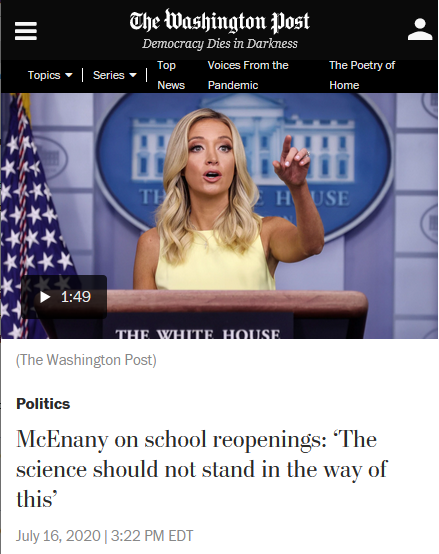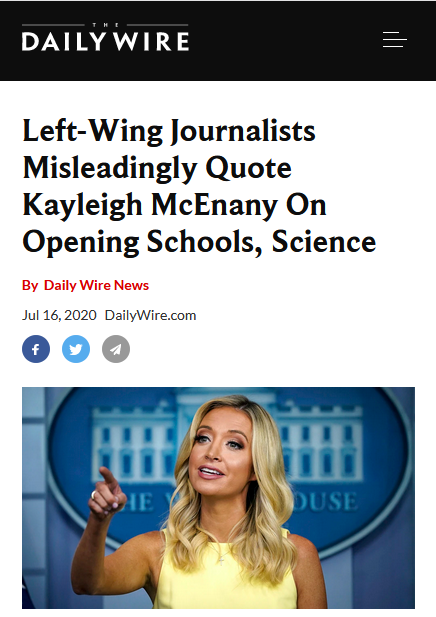
BY MICHAEL KRUSE AND RENUKA RAYASAM
|
With help from Myah Ward
SEASON TWO — When the novel coronavirus didn’t “go away” or “fade away” or “like a miracle” “sort of just disappear,” when the case count kept going up and his poll numbers kept going down, when his rally in Tulsa was an embarrassing flop and the next one was nixed because it was threatening to be another, it was inevitable that Donald Trump was going to resurrect the briefings that became, at least for a time early this spring, something of a hit show.
This president doesn’t like to cede or share the spotlight, and immediately conspicuous in the briefing room at the White House tonight was the absence of Mike Pence, of Tony Fauci and Deborah Birx, of any of the other collection of public health pros and administration officials who were recurring characters in these sessions back in March and April. “I alone can fix it,” Trump said in Cleveland, on July 21, 2016, and here he was, exactly four years later, alone.
Trump believes that appearances are paramount, “that how you look is more important than how you sound,” as Roger Stone once said to me, and “how you come across is more important than the words you use.” The stage in the White House is about as important as it gets. The person front and center there can’t help but look like he or she’s in charge. Trump gave it up some three months back — and ever since his standing has sunk.
The importance he places on visuals might be why, on that stage this evening, as he talked more than he ever has about the importance of wearing a mask, he didn’t wear one. He took his mask out of his suit pocket to show it to reporters — but he didn’t put it on.
And lastly, and this is one of Trump’s most deep-seated convictions, he believes he can make something so simply by saying it enough times and with enough force. He is ever endeavoring to bend reality to his will, to succeed without actually having to succeed, channeling the relentless, practically blind optimism of Norman Vincent Peale. Yet tonight, at times, he sounded uncharacteristically realistic. “It will, probably, unfortunately,” he said, “get worse before it gets better — something I don’t like saying, but that’s the way it is.”
But Peale won out in the end. Trump reiterated his contention that “the virus will disappear.” And one of the last things he said? It had nothing to do with the coronavirus. “The stock market,” he said, “had another good day.”
So it went in the less-than-a-half-hour episode of the second season of Trump’s coronavirus briefings. When it comes, though, to second seasons, it’s worth recalling that Trump’s track record isn’t good. It was the first season of “The Apprentice” that was by far the most successful. And this, needless to say — managing this pandemic, or even the public perception of how he’s doing — is a hell of a lot harder than making reality TV.
A message from Emergent BioSolutions:
Our global team is going full speed to develop potential therapies that may help treat COVID-19. At the same time, we’re collaborating on innovative vaccine candidates that can be made by the millions. Discover what we’re doing right now.
Welcome to POLITICO Nightly: Coronavirus Special Edition. Wish me luck — I’m off for the next few days while I attempt a cross state move. I’ll be back next Tuesday. Reach out rrayasam@politico.com or on Twitter at @renurayasam .
| THE NIGHTLY DEBATE |
Nightly asked: If you were in charge of your school district or university, how would you design the fall semester? If you have children in school or college, what are your plans for their education this year? Answers have been edited and emphasis added in bold.
“If a vaccine can reach us by December, I would postpone the start of the school year by those three months. Worst case, it buys time to prepare the district for a potential return.
“If for some reason we are compelled to have school, I would focus on online classes for a daily period of time, but also would schedule recess/playground time/social activities for small groups that bring kids back to school on a staggered schedule that is optimized to have as few people on campus at a single time as possible.
“The greatest issue is for working parents. How do they keep their jobs and care for their kids at home? One way to attempt to address this is by having trusted groups of families that can support multiple kids at one home. A better solution would be to offer Caretaker Basic Income that pays a parent $2,000 to $2,500 per month, depending on their cost of living, to stay at home during the period kids are required to take at-home and online classes. I would also add a broadband stipend to make sure that kids have access to sufficient internet for their classes and potentially even to buy a low end laptop.
“As far as my kids: 10, 13 and 16. What I wrote is exactly what I suggested when I was asked.” — Mark Cuban, owner of the Dallas Mavericks
“My kids, 3 and 6 years old, are slated to go back to day care and school in a few weeks. It’s clear that they need more socialization and stimulation, and working full-time while parenting isn’t sustainable. But I still feel deeply ambivalent about sending them back, even though I live in a state that currently has low community spread. It’s infuriating that the federal government’s failure to respond to the pandemic has put parents, teachers and kids in this impossible position.” — Julia Marcus, epidemiologist at Harvard Medical school
“In my ideal world, school districts would shift to providing flexible resources for those families, up to and including refunding or voucherizing some of the money the system would have spent educating their children in person. Some parents desperately need someone to keep their children safe and supervised during the day and are being offered Zoom tutorials on how to make dioramas instead. Meanwhile, parents of older or more independent children may have less need for oversight, but are utterly at sea when it comes to administering trigonometry lessons.
"For many households, an education rebate of a few thousand dollars — a small fraction of the amount that the average public school district spends per student — could mean the ability to buy computers and textbooks or hire tutors and babysitters they otherwise couldn't afford. The vouchers or rebates could create a large market for innovative solutions, and maybe restore some sense of control to the millions of parents who feel battered by circumstance under coronavirus.” — Katherine Mangu-Ward, editor-in-chief, Reason magazine
“What I have heard about school reopening is alarming. Remote learning is hugely challenging for parents and teachers who have young kids. But by saying that we're going to reopen without having achieved a certain metric or achieved safety based on data and science seems very dangerous to me. Thankfully, my son graduated from college but my daughter is going to remote learn. Reopening and pretending that we're not facing a deadly global pandemic that has been completely mishandled by the White House and in my state by the governor is a recipe for disaster.” — Rep. Veronica Escobar (D-Texas)
“My children are going back to school on time and in full — as they should, and as all of America should. I would encourage all schools to go back, adopting whatever standards they deem appropriate, so long as it’s in person and fully functioning. Parents and kids need it — and science demonstrates we can open safely.”
— REP. CHIP ROY (R-TEXAS)
|
“If our public schools open, we’ll send our kids. But now they’re planning to start online, so I wish we could focus less on this debate and more on designing a virtual classroom experience that isn’t a total joke. Last spring was basically two days of homework and three days of Fortnite — I’m pretty sure we can do better than that. Plus I suck at algebra.” — Matt Bai, contributing columnist for The Washington Post
“I would use alternative learning spaces to maximize the amount of face-to-face learning children have with a teacher and would demand substantial investments from our federal government so our school district can hire more teachers. I would also encourage cities to repurpose unused spaces like theatres , office spaces, and design spaces to classrooms. I would fight to increase experiential and outdoor learning opportunities for kids. Outdoor spaces are much safer for kids making this pandemic an opportune time for children to learn more about their relationship to the environment and work on outdoor science experiments. I would encourage parks department personnel to become a major contributor to outdoor experiential learning.
“We need to ensure every child and teacher has access to Wi-Fi and stipends for any books. For any in-person activities, I would make masks and gloves mandatory, consistently encourage Covid testing amongst staff and students, and make cleaning and ventilation services mandatory.
“Our own kids will be returning to school on a part-time basis in accordance with our local department of education.” — Jamaal Bowman, Democratic New York congressional candidate
“I would have the children come into school on rotating days, and I would provide businesses with tax credits if they give unused space to schools so that the kids can separate more. I’d require masks, improve ventilation, and I would also experiment with pooling corona tests: If possible, have multiple people contribute to one sample so that you can cheaply and easily see if anyone has tested positive before going through the expense of testing individuals.” — Nicholas Thompson, editor-in-chief, Wired magazine
“The risks and feasibility of opening schools will hinge on the prevalence of Covid-19 in their community. If we were to open schools in Austin today, we estimate that a school with 500 students might have three students show up infected during the first week alone. The more we are able to slow spread and reduce cases, the more feasible and safe opening schools will be.” — Lauren Ancel Meyers, a professor of integrative biology at the University of Texas at Austin
“The decision on whether to reopen schools in person, online or with a mix is ultimately up to local school districts, teachers and public health officials. I am committed to supporting schools by pushing for passage of the Coronavirus Child Care and Education Relief Act. This legislation provides $430 billion to assist child care facilities, K-12 school districts and institutions of higher education with reopening costs.” — Sen. Tim Kaine (D-Va.)
“Let 1,000 vouchers bloom. Schools face very difficult choices this fall, between higher risks of infection and worse learning outcomes. We should admit we don’t know how to make these choices well collectively, and empower parents to choose instead. Take the per-student school budget and offer a big fraction of it to parents as a voucher, to pay for home schooling they run themselves, for a neighbor to set up a one-house schoolhouse, for a larger private school, or to use at a qualifying local public school. Each option would set its own learning policies and also policies on distancing and testing. Let parents weigh family infection risks against learning quality risks, using what they know about available options, and their children’s risks, learning styles and learning priorities.
“Yes, schools may suffer a large initial revenue shortfall this way; maybe they could rent out some rooms to new private school ventures. Yes, some children will end up with regretful schooling outcomes, though that seems inevitable no matter what we do. Yes, there should be some limits on teaching quality, but we should be forgiving at first; after all, public schools don’t know how to ensure quality here either. And maybe let any allowed option start a month or two late, if they also end later next summer; after all, we aren’t giving them much time to get organized.” — Robin Hanson, economist at George Mason University
“As a pediatrician and parent, I know how important it is to get students back in the classroom. We all want that. And with each day that passes, we know that communities of color — and students in those communities — likely will suffer disproportionately, just as we’ve seen with Blacks, Latinos and Native Americans across the nation in the first six months of this pandemic. In America, property taxes provide a large part of the funding for schools, so wealthy communities may be able to make the necessary changes while schools in lower income communities are left behind. We immediately need federal and state resources in place so that schools can reopen safely and equitably. Without adequate funding and better control of this pandemic, we’re setting ourselves up for failure. And tragically, we’ll be failing the students who can least afford this lost time to learn and thrive.”
— RICHARD BESSER, PRESIDENT AND CEO ROBERT WOOD JOHNSON FOUNDATION
|
“I’d set in-person education back to start as soon as community transmission is under control, we have highly accessible universal Covid testing and the most vigorous contact tracing program possible. If we were to issue stay at home orders in Texas now, and then use the time while we are at home to put these pieces in place, we could open up for in-person education as early as October.
“We have three kids who attend public schools in El Paso. They will be starting 8th, 7th and 4th grades this fall. Our school district has given us the choice between hybrid (in-person and distance learning) and distance learning only. We will choose distance learning only until the conditions are in place to protect the teachers, support staff and other educators, the kids, and the parents and grandparents of kids.” — Beto O’Rourke, former Texas congressman and former presidential candidate
“I say, without a hint of sarcasm, that I have never been happier about not being in charge of our school district or my university. Going back in person seems very unlikely in parts of the country experiencing a spiking pandemic. I suspect most K-12 districts and colleges will be online sooner rather than later, and we need to focus tremendous energy and resources on improving that experience for young, low-income and other disadvantaged students — in other words, those who will be hurt the most by a lack of face-to-face learning this fall.
“I have a high school and a college student, my wife is an early childhood teacher, and I teach at the college level. The college student will be online through the fall if not all year; the high schooler has the option for f2f or online and wants to try f2f. My school of education is online through the fall, except for one program that will need to be at least partially f2f … and guess which program I teach in this fall? Every day we read reports that all basically say (1) You’re probably fine to go back, (2) but the science is still all over the place, (3) so use your best judgment. We all want to get back to f2f as soon as possible, but at what cost? It’s a constant source of anxiety for us.” — Jonathan Plucker, professor in the Johns Hopkins School of Education
“Had I been in charge of a school district in May, our team would’ve set as our goal having all students in class full-time in September. Then we would’ve figured out all of the things necessary to get that done safely; and if full-time and in-person wasn't possible, we would’ve gradually worked back from there. The idea would be to return to normal schedules as swiftly as conditions allow — but no swifter. Having said that, we have to realize that even if each of America's 13,500 school districts set that very same goal, they’d reach very different conclusions. District to district, there are big differences in how crowded schools are, how many buses are needed, the prevalence of Covid cases, the views of parents, the views of teachers and more. This is where America's highly decentralized system of schools shows its value.
“America is big and diverse, and conditions and sentiments will change. So the national picture that emerges this fall might look completely unintelligible when viewed from the nation’s capital, but it could well be intelligent from viewed from each particular district." — Andy Smarick, senior fellow, Manhattan Institute
“I think it is important to have community transmission controlled before you can discuss having in-person education. We still don’t understand enough about the transmission dynamics between kids and from kids to adults. We know that asymptomatic transmission is a problem and do not know enough about how children with asymptomatic (or even symptomatic disease) do long term. We would feel horrible in 6 months if we found out that putting kids in a setting and they were to get this disease put them at risk for long term medical problems.” — Krutika Kuppalli, infectious diseases physician and vice chair of the Global Health Committee at the Infectious Diseases Society of America
“The name of the game is options and adaptability. Options for parents and staff for online, hybrid and in-person learning. Adaptability to respond to local and individual health and educational issues. We must not underestimate the educational urgencies for students in our quest for good health and safety. We all need to come to terms with levels of risk, make personal decisions for our health, family and educational needs, and wear masks damnit!” — Margaret Spellings, secretary of Education under President George W. Bush
“I have zero new ideas about this but one. It teaches patience. It teaches ‘This too shall pass.’ Free cars take every school kid every day to a drive-in movie about vaccine development. The current catastrophe would make watching the boring PowerPoints and medical exams more exciting. As soon as the vaccine is approved, and the first 100 million doses made, the kids get their shots, sleep off the side effects, and head into winter break dreaming of spring semester and what we will pretend is normal.” — Virginia Heffernan, the host of “Trumpcast” and a columnist for the Los Angeles Times, Wired and the Economist’s 1843
DON'T MISS - POLITICO'S NEW "FUTURE PULSE" NEWSLETTER: The coronavirus pandemic accelerated long-simmering trends in health care technology and one thing is certain: The health care system that emerges from this crisis will be fundamentally different than the one that entered. From Congress and the White House, to state legislatures and Silicon Valley, Future Pulse spotlights the politics, policies, and technologies driving long-term change on the most personal issue for voters: Our health. SUBSCRIBE NOW.
| FIRST IN NIGHTLY |
CHILD CARE’S COVID CRISIS — The collapse of the child care industry is threatening to stoke racial and gender inequities and putting pressure on Congress to address the crisis in its new round of coronavirus aid.
Black and Latina women are suffering a double-barreled blow as coronavirus-induced shutdowns batter the industry, Eleanor Mueller writes, because they dominate the ranks of child care providers and have long struggled to gain access to the services for their own kids.
The sector, which saw 60 percent of its programs close at the height of the pandemic before rebounding slightly, is still down some 237,000 workers from last year — a number that’s likely to grow as states shut down again, economists say. Some projections show the industry could permanently lose half its programs. Two in 5 child care providers this month said they will shut for good without an infusion of federal funding.
A message from Emergent BioSolutions:
| COVID-2020 |
THE HAGGLING CONTINUES — Senate Republicans and the White House remain plagued by deep ideological divides over major elements of the next coronavirus relief package, creating an opening for Democrats as the pace of negotiations accelerates, John Bresnahan, Marianne LeVine and Andrew Desiderio write.
With coronavirus cases soaring across the country, the U.S. economy in near tatters, and elections just over 100 days away, senior White House officials and the Senate GOP leadership have yet to find agreement on big portions of the soon-to-be-released Republican proposal. They’re still undecided on whether to propose a payroll tax cut or how to respond to the end of enhanced unemployment payments for millions of Americans. Those $600-per-week unemployment checks begin to phase out in a few days.
| ASK THE AUDIENCE |
Nightly asks you: Have you gotten tested for Covid-19? Do you want to get tested but are unable to? Tell us your testing experience. Send us your story with our form and we’ll include some of the responses in Friday’s Nightly.
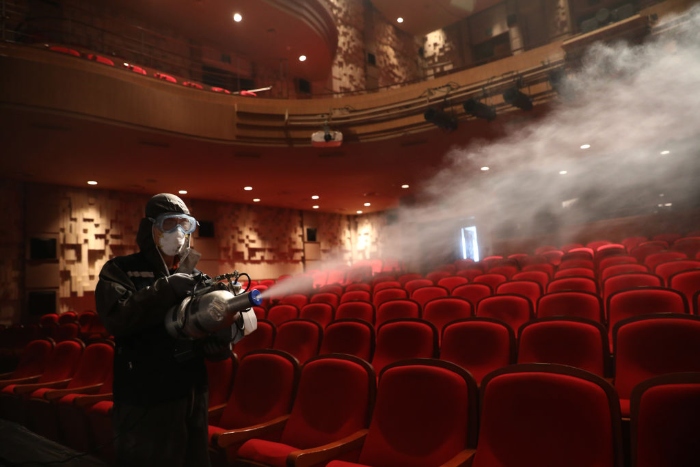
A disinfection worker sprays antiseptic solution in a theater in Seoul. | Getty Images
| THE GLOBAL FIGHT |
COVID FUNDING WITH STRINGS ATTACHED — With governments at risk of sinking under massive Covid-related debt, and demand for financial support from international organizations outstripping supply, the terms of public relief funding are tightening around the world, Ryan Heath writes.
After more than 90 hours of negotiating among European national leaders, the EU’s executive arm (the European Commission) this morning won permission to borrow $865 billion from financial markets to help the most beleaguered EU countries — including Italy and Spain — recover from Covid-19. The breakthrough came only after a group of frugal EU countries insisted that half the funds be delivered as loans rather than grant payments, and that $350 billion be tied to policy reforms. A separate push to attach rule of law conditions to the funding failed amid questions around how it could be enforced.
The International Monetary Fund is shifting to attaching green conditions to its next round of Covid-19 support, after more than 100 countries have asked, now that emergency support has been delivered. Meanwhile, national governments are applying strict conditionality on business aid: no dividends or share buybacks for example, and nothing for businesses registered in tax havens. NGOs are joining the pile-on, arguing for green conditions and human rights due diligence as Covid funding conditions.
JOIN THURSDAY AT 1:30 p.m. EDT – A GLOBAL RALLYING CRY: The Black Lives Matter movement has gone global with anti-racism protests sweeping cities around the world. What does the racial reckoning look like abroad? Join Global Translations author Ryan Heath for a conversation on how the fight for equality has become a worldwide rallying cry following the killing of George Floyd. REGISTER HERE.
| NIGHTLY NUMBER |
31
The number of states on the New York and New Jersey list from which travelers are subject to a two-week quarantine upon arrival. An additional 10 states were added to the list today as Covid-19 caseloads continue to surge in much of the country, which is updated weekly.
|
| PARTING WORDS |
SUMMER RETURNS IN MOSCOW — It wasn’t that long ago, in early June, that Russia’s capital Moscow was eerily quiet as the Kremlin enforced one of the world’s harshest coronavirus lockdowns. With the capital reporting more than 10,000 new cases a day, residents needed special permission via QR codes on their phones for trips outside, and most Muscovites cowered fearfully in their flats.
Flash forward nearly two months and the contrast couldn’t be greater, Vijai Maheshwari writes: Parks, restaurants, museums, gyms, night clubs — even strip clubs — are open once again. Ever since Russian President Vladimir Putin jolted the city out of its corona slumber with a massive June 24 Victory Day parade to celebrate the 75th anniversary of World War II, Moscow is churning at full blast again. The cavalier attitude toward wearing masks and social distancing among most Russians makes a deadlier second wave in the fall — or sooner — even more likely. But for now, the corona nihilists have the upper hand in Russia: A survey by Moscow’s Higher School of Economics found that a staggering third of Russians don’t believe in the coronavirus pandemic and consider the threat to be exaggerated.
A message from Emergent BioSolutions:
We go after public health threats. In the fight against COVID-19, we are going full speed to develop potential new therapies and vaccine candidates.
We go for critical innovations. We are developing two potential hyperimmune treatments for severe hospitalized COVID-19 patients and individuals at risk. Based on proven technology, the research and testing are underway.
We go in partnership with others. We are working with industry innovators to bring COVID-19 vaccine candidates to market. We have the capacity to manufacture vaccines in the tens to hundreds of millions, and we are propelling development forward.
We go. And go. From fighting anthrax to helping prevent smallpox and developing vaccine candidates, we go all in. Because public health threats will never stop. And neither will we.
See how we go all in.
We go for critical innovations. We are developing two potential hyperimmune treatments for severe hospitalized COVID-19 patients and individuals at risk. Based on proven technology, the research and testing are underway.
We go in partnership with others. We are working with industry innovators to bring COVID-19 vaccine candidates to market. We have the capacity to manufacture vaccines in the tens to hundreds of millions, and we are propelling development forward.
We go. And go. From fighting anthrax to helping prevent smallpox and developing vaccine candidates, we go all in. Because public health threats will never stop. And neither will we.
See how we go all in.
Did someone forward this email to you? Sign up here.
Follow us on Twitter
Renuka Rayasam @renurayasam
|
FOLLOW US
|

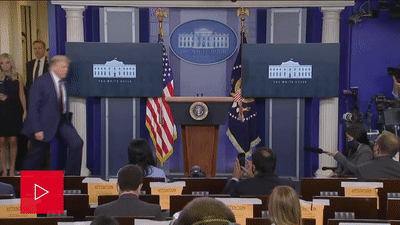
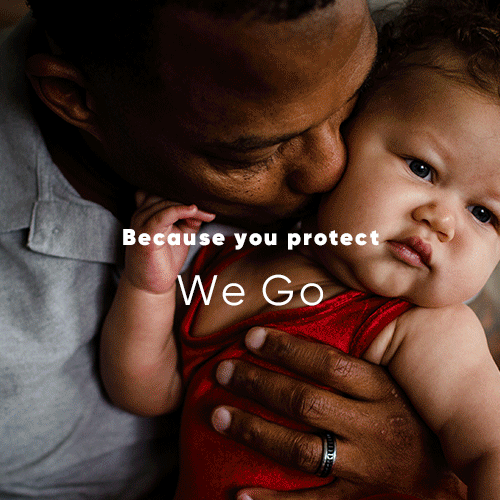






 h, Lord, please don’t let me be misunderstood.”
h, Lord, please don’t let me be misunderstood.”

